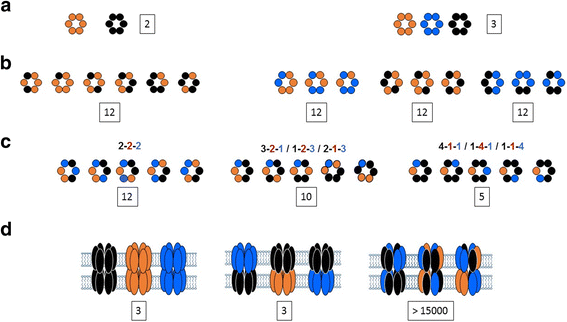Cardiac Cx43, Cx40 and Cx45 co-assembling: involvement of connexins epitopes in formation of hemichannels and Gap junction channels
- PMID: 28124623
- PMCID: PMC5267329
- DOI: 10.1186/s12860-016-0118-4
Cardiac Cx43, Cx40 and Cx45 co-assembling: involvement of connexins epitopes in formation of hemichannels and Gap junction channels
Abstract
Background: This review comes after the International Gap Junction Conference (IGJC 2015) and describes the current knowledge on the function of the specific motifs of connexins in the regulation of the formation of gap junction channels. Moreover the review is complemented by a summarized description of the distinct contribution of gap junction channels in the electrical coupling.
Results: Complementary biochemical and functional characterization on cell models and primary cells have improved our understanding on the oligomerization of connexins and the formation and the electrical properties of gap junction channels. Studies mostly focused cardiac connexins Cx43 and Cx40 expressed in myocytes, while Cx45 and Cx30.2 have been less investigated, for which main findings are reviewed to highlight their critical contribution in the formation of gap junction channels for ensuring the orchestrated electrical impulse propagation and coordination of atrial and ventricular contraction and heart function, whereas connexin dysfunction and remodeling are pro-arrhythmic factors. Common and specific motifs of residues identified in different domain of each type of connexin determine the connexin homo- and hetero-oligomerization and the channels formation, which leads to specific electrical properties.
Conclusions: These motifs and the resulting formation of gap junction channels are keys to ensure the tissue homeostasis and function in each connexin expression pattern in various tissues of multicellular organisms. Altogether, the findings to date have significantly improved our understanding on the function of the different connexin expression patterns in healthy and diseased tissues, and promise further investigations on the contribution in the different types of connexin.
Figures



Similar articles
-
Relating specific connexin co-expression ratio to connexon composition and gap junction function.J Mol Cell Cardiol. 2015 Dec;89(Pt B):195-202. doi: 10.1016/j.yjmcc.2015.11.008. Epub 2015 Nov 6. J Mol Cell Cardiol. 2015. PMID: 26550940
-
Gap junction protein phenotypes of the human heart and conduction system.J Cardiovasc Electrophysiol. 1995 Oct;6(10 Pt 1):813-22. doi: 10.1111/j.1540-8167.1995.tb00357.x. J Cardiovasc Electrophysiol. 1995. PMID: 8542077
-
Expression and regulation of connexins in cultured ventricular myocytes isolated from adult rat hearts.Pflugers Arch. 2002 Mar;443(5-6):676-89. doi: 10.1007/s00424-001-0747-z. Epub 2002 Jan 15. Pflugers Arch. 2002. PMID: 11889564
-
Alterations in cardiac connexin expression in cardiomyopathies.Adv Cardiol. 2006;42:228-242. doi: 10.1159/000092572. Adv Cardiol. 2006. PMID: 16646594 Review.
-
Remodelling of gap junctions and connexin expression in diseased myocardium.Cardiovasc Res. 2008 Oct 1;80(1):9-19. doi: 10.1093/cvr/cvn133. Epub 2008 Jun 2. Cardiovasc Res. 2008. PMID: 18519446 Free PMC article. Review.
Cited by
-
Zippering Up a Role for ZO-1 in Atrioventricular Node Conduction and Disease.Circ Res. 2020 Jul 3;127(2):298-300. doi: 10.1161/CIRCRESAHA.120.317291. Epub 2020 Jul 2. Circ Res. 2020. PMID: 32614716 Free PMC article. No abstract available.
-
Reprogramming of connexin landscape fosters fast gap junction intercellular communication in human papillomavirus-infected epithelia.Front Cell Infect Microbiol. 2023 May 16;13:1138232. doi: 10.3389/fcimb.2023.1138232. eCollection 2023. Front Cell Infect Microbiol. 2023. PMID: 37260709 Free PMC article.
-
Abnormal Expression of Connexin43 in Cardiac Injury Induced by S-Band and X-Band Microwave Exposure in Rats.J Immunol Res. 2021 Dec 17;2021:3985697. doi: 10.1155/2021/3985697. eCollection 2021. J Immunol Res. 2021. PMID: 34957312 Free PMC article.
-
The Role of Infarct Border Zone Remodelling in Ventricular Arrhythmias: Bridging Basic Research and Clinical Applications.J Cell Mol Med. 2025 Apr;29(7):e70526. doi: 10.1111/jcmm.70526. J Cell Mol Med. 2025. PMID: 40159640 Free PMC article. Review.
-
Gene therapy for atrial fibrillation - How close to clinical implementation?Int J Cardiol. 2019 Dec 1;296:177-183. doi: 10.1016/j.ijcard.2019.07.057. Epub 2019 Aug 7. Int J Cardiol. 2019. PMID: 31439427 Free PMC article. Review.
References
Publication types
MeSH terms
Substances
LinkOut - more resources
Full Text Sources
Other Literature Sources
Miscellaneous

